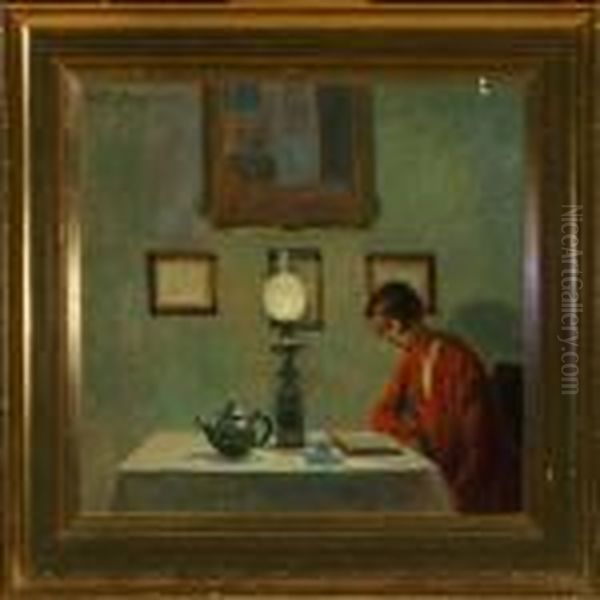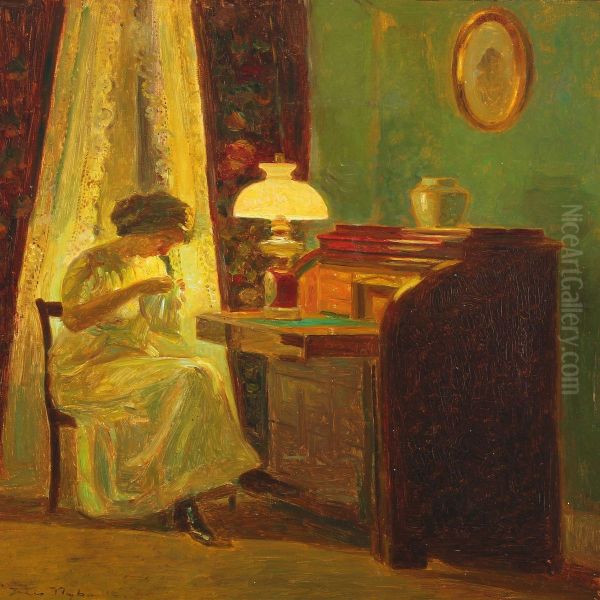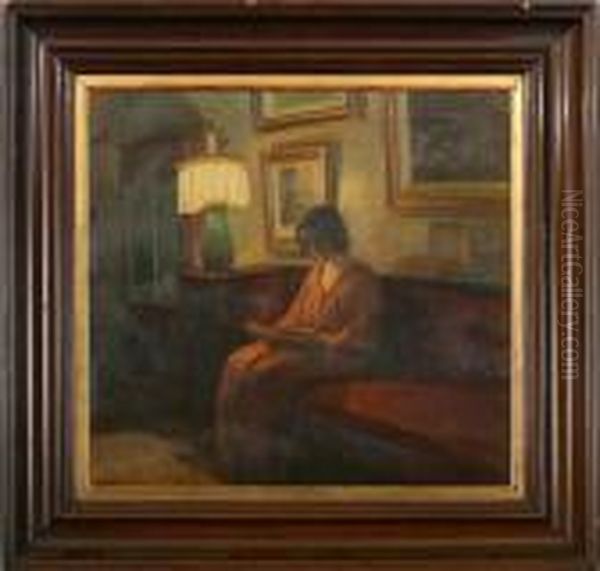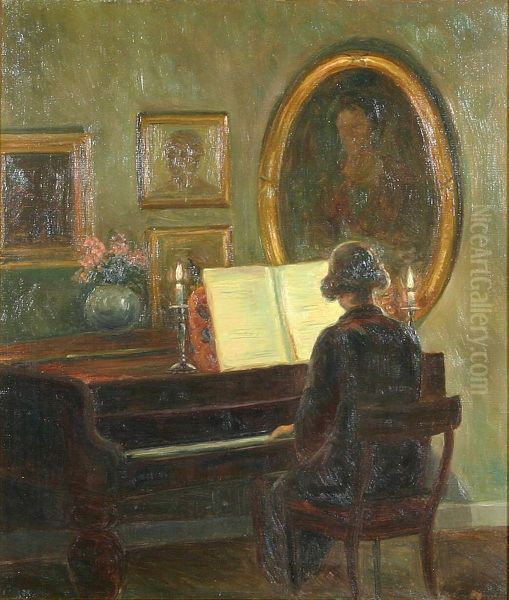Poul Friis Nybo (1869-1929) stands as a significant, albeit sometimes overlooked, figure in Danish art history, particularly noted for his sensitive and atmospheric depictions of domestic interiors. Working during a period of rich artistic transition in Denmark and Europe, Nybo carved a niche for himself, creating works that resonate with quiet contemplation, subtle light, and a distinct sense of presence. Though often discussed in relation to the more famous Vilhelm Hammershøi, Nybo possessed his own unique sensibility, contributing thoughtfully to the genre of interior painting that flourished in Copenhagen around the turn of the 20th century.
Early Life and Artistic Awakening
Born in 1869, Poul Friis Nybo came of age during a dynamic era in Danish culture. The late 19th century saw the lingering influence of the Danish Golden Age give way to Realism, Naturalism, Symbolism, and the burgeoning modernist impulses. This vibrant artistic milieu provided the backdrop for Nybo's formative years. His formal artistic training took place at the prestigious Royal Danish Academy of Fine Arts in Copenhagen, which he attended from 1887 to 1892. The Academy, while steeped in tradition, was also a place where new ideas were debated and explored.
Crucially, Nybo sought further instruction beyond the Academy, studying under the influential painter Kristian Zahrtmann (1843-1917). Zahrtmann ran an independent school, Kunstnernes Frie Studieskoler, which served as an alternative to the Academy and attracted many talented young artists seeking a less rigid approach. Zahrtmann was known for his bold use of color, his fascination with historical subjects, and his encouragement of individuality among his students. Studying with Zahrtmann undoubtedly exposed Nybo to different technical possibilities and perhaps a greater emphasis on personal expression.
The Influence of Kristian Zahrtmann
Kristian Zahrtmann's school was a crucible for talent in Danish art. He fostered an environment where experimentation, particularly with color and historical narrative, was encouraged. While Nybo's later work would diverge significantly from Zahrtmann's often dramatic and intensely colorful historical scenes, the period spent under his tutelage was likely formative. Zahrtmann's emphasis on strong composition and the psychological potential of a scene may have resonated with Nybo, even as he translated these concerns into a much quieter, more introspective key.

Many prominent Danish artists passed through Zahrtmann's school, forming a generation that shaped Danish art in the early 20th century. Figures like Johannes Larsen (1867-1961) and Fritz Syberg (1862-1939), who became key members of the "Funen Painters" group known for their depictions of rural life, studied with Zahrtmann. Others included Poul S. Christiansen (1855-1933), known for his powerful, expressive works, and Oluf Hartmann (1879-1910), whose promising career was cut short. Nybo's association with this environment placed him amidst a cohort of ambitious young painters exploring diverse artistic paths.
Finding a Voice: The Allure of the Interior
Following his studies, Nybo began to exhibit his work. An early and significant showing was at the Große Berliner Kunstausstellung (Great Berlin Art Exhibition) in 1892. This indicates an early ambition to engage with the broader European art scene. Over time, Nybo gravitated towards the subject matter that would define his career: the domestic interior. This was not merely a choice of setting, but an exploration of atmosphere, light, and the quiet dramas of everyday life.
His interiors are often characterized by a sense of stillness and order. He frequently depicted rooms bathed in a soft, diffused light, filtering through windows or emanating from unseen sources. The color palettes are typically restrained, favoring subtle harmonies of grays, browns, creams, and muted blues or greens. This tonal approach creates a cohesive and often melancholic or contemplative mood, inviting the viewer into a private, hushed world.
Nybo's interiors are rarely empty. They are often inhabited by solitary female figures, engaged in quiet activities: reading, sewing, playing the piano, or simply lost in thought. These figures are not usually presented as specific portraits but rather as integral components of the overall atmosphere. Their presence adds a human element, a focal point for the room's psychological resonance, yet they often seem absorbed in their own world, enhancing the sense of intimacy and introspection.
The Hammershøi Sphere: Shared Sensibilities
It is impossible to discuss Poul Friis Nybo without acknowledging his connection to the so-called "Hammershøi school" or, more accurately, the circle of Copenhagen artists exploring similar themes of quiet interiors. Vilhelm Hammershøi (1864-1916) is the most celebrated exponent of this style, renowned for his spare, enigmatic interiors, often featuring his wife Ida as a solitary figure, frequently seen from behind. Hammershøi's work is characterized by its rigorous geometry, its masterful handling of gray tones, and its profound sense of silence and mystery.

Nybo clearly shared sensibilities with Hammershøi. Both artists were fascinated by the play of light in domestic spaces, the evocative power of empty or sparsely furnished rooms, and the quietude of solitary figures. However, Nybo's approach often feels slightly warmer and less austere than Hammershøi's. His light can be softer, his inclusion of decorative details perhaps more frequent, and his figures sometimes feel more personally present, even when introspective.
Another key figure in this group was Carl Holsøe (1863-1935). Holsøe's interiors are often more detailed and perhaps more conventionally beautiful than Hammershøi's, frequently featuring elegant furniture, porcelain, and women engaged in domestic pursuits. Nybo's work can be seen as occupying a space between the stark minimalism of Hammershøi and the more detailed elegance of Holsøe. He shared their interest in light and atmosphere but developed his own distinct balance of elements. Peter Ilsted (1861-1933), Hammershøi's brother-in-law, also worked in a similar vein, particularly known for his mastery of the mezzotint technique to reproduce interior scenes.
International Resonances: Whistler and Tonalism
The focus on subtle tonalities, atmospheric effects, and simplified compositions seen in Nybo's work also connects him to international trends, particularly the influence of the American expatriate artist James McNeill Whistler (1834-1903). Whistler, working primarily in London and Paris, was a major proponent of Tonalism and the Aesthetic Movement. He famously created "arrangements" and "nocturnes," emphasizing color harmony and mood over narrative detail.
Whistler's sophisticated use of limited palettes, his interest in capturing fleeting effects of light, and his emphasis on the painting as an object of beauty in itself, found echoes across Europe. Artists like Nybo, Hammershøi, and Holsøe, while deeply rooted in their Danish context, participated in this broader European sensibility that valued suggestion, atmosphere, and refined aesthetics. Nybo's careful compositions and his nuanced handling of light and shadow align well with the principles championed by Whistler.
While Nybo's interiors differ in subject and mood from the often more overtly modern or bustling scenes depicted by French contemporaries like Edgar Degas (1834-1917) in his interiors, or the intimate, patterned spaces of Édouard Vuillard (1868-1940) and Pierre Bonnard (1867-1947), there is a shared late 19th and early 20th-century interest in exploring the psychological and aesthetic potential of the indoor environment. Nybo's contribution lies in his distinctively Nordic interpretation, emphasizing stillness and a particular quality of light.
Representative Works: Capturing Quiet Moments

Several works exemplify Poul Friis Nybo's artistic concerns and stylistic approach. Piano Practice (Pianoøvelse) is one such painting. Typically, such a scene would depict a figure, likely female, seated at a piano within a carefully rendered domestic interior. The focus would be on the interplay of light across the surfaces of the room – the polished wood of the piano, the texture of fabrics, the reflections on the floor – and on the quiet concentration of the pianist. The mood would likely be one of calm absorption, the music implied rather than heard, contributing to the overall atmosphere of peaceful domesticity.
Another key work, specifically mentioned as being in the collection of the Skagens Museum, is A Woman in her Drawing Room or A Woman in her Salon (En kvinde i sin stue / Une femme dans son salon). This title suggests a quintessential Nybo subject. We can envision a well-appointed room, perhaps with elegant furniture and decorative objects, illuminated by soft daylight. A woman, the focal point, might be seated, perhaps reading or sewing, her posture conveying repose or introspection. The painting would likely emphasize the relationship between the figure and her surroundings, the room itself becoming a reflection of a certain state of mind or way of life. The Skagens Museum's acquisition of this work underscores its perceived importance within Danish art.
Other works, known through exhibitions or auctions, further illustrate his themes. Titles like Interior with Woman Reading or Sunshine in the Living Room reinforce his consistent focus. A work auctioned as Vattenspegel i Parc Monceau - Paris (Waterspiegel in Parc Monceau - Paris) suggests that Nybo did occasionally venture beyond the domestic interior, capturing outdoor scenes during his travels, likely applying his sensitivity to light and atmosphere to the urban landscape. However, the interior remained his primary domain.
Exhibitions, Recognition, and Collections
Nybo actively exhibited his work throughout his career, both within Scandinavia and internationally. His participation in the Berlin exhibition early on, and later showings in Paris, including at the prestigious Salon, demonstrate his engagement with the wider art world. Receiving recognition at the Paris Salon, as mentioned in some sources, would have been a significant achievement, placing his work before a discerning international audience and critics.

His paintings found their way into important Danish collections. The presence of his work in the Skagens Museum is noteworthy. While Skagen is primarily associated with the Skagen Painters (like Michael Ancher, Anna Ancher, and P.S. Krøyer) known for their vibrant plein-air scenes of fishermen and coastal life, the museum also collects works that represent broader trends in Danish art. Nybo's inclusion suggests his work was valued for its quality and its representation of a significant aspect of Danish painting. Mentions of works also being held by the ARoS Aarhus Art Museum further solidify his standing within Danish public collections.
The continued appearance of his works at auction indicates an ongoing market interest. Paintings like Vattenspegel i Parc Monceau - Paris and Mamsel på en skrivepult (Girl at a Desk) achieving sales demonstrate that collectors still value his skillful technique and evocative moods. The prices fetched reflect his status as a respected, though perhaps not top-tier, name from this period of Danish art.
Context within Danish Art: Beyond Skagen
Poul Friis Nybo's career unfolded alongside diverse movements in Danish art. While the Skagen Painters captured the light and life of the northern coast, other artists explored different paths. Symbolism had its proponents, such as the highly individualistic J.F. Willumsen (1863-1958), whose work often carried strong emotional or philosophical weight. The Funen Painters, including former Zahrtmann students like Larsen and Syberg, focused on the landscapes and daily life of their native island.
Nybo and the Copenhagen interior painters offered a different perspective, turning inward to explore the subtleties of domestic space and psychology. Their work represented a quieter, more urban sensibility compared to the often rugged or communal scenes of Skagen or Funen. They were perhaps less concerned with grand narratives or overt symbolism, focusing instead on the nuanced poetics of the everyday, the interplay of light and shadow, and the creation of atmosphere. Nybo's contribution was significant in refining this particular genre.
Later Life and Legacy
Sources suggest that Poul Friis Nybo suffered from ill health in his later years, leading to a decline in his artistic output. He passed away in 1929. His legacy rests on his consistent and sensitive exploration of the interior genre. He was not a radical innovator in the mold of some of his contemporaries, but he was a master craftsman with a distinct ability to capture mood and atmosphere.
His paintings offer a window into the bourgeois domestic interiors of his time, but more importantly, they explore universal themes of solitude, contemplation, and the beauty found in quiet moments. He skillfully used light, color, and composition to create spaces that feel both real and psychologically resonant.
In the art historical narrative, he remains closely associated with Hammershøi and Holsøe, together forming the core of the Copenhagen interior school. While Hammershøi's international reputation has soared in recent decades, Nybo's work continues to be appreciated by connoisseurs of Danish art and those drawn to the quiet beauty and subtle emotional depth of his paintings. His works in museums and those that appear on the market serve as reminders of his dedicated artistry and his contribution to the rich tapestry of Danish painting at the turn of the 20th century.
Conclusion: An Artist of Quietude
Poul Friis Nybo dedicated his career to the nuanced depiction of interior spaces, often populated by solitary women engaged in quiet pursuits. Influenced by his training under Kristian Zahrtmann and finding kinship with contemporaries like Vilhelm Hammershøi and Carl Holsøe, he developed a distinctive style characterized by subtle tonalities, masterful handling of light, and a profound sense of atmosphere. His work resonates with the Tonalist sensibilities also seen in Whistler, emphasizing mood and aesthetic harmony.
Though perhaps overshadowed by the enigmatic power of Hammershøi, Nybo remains a significant figure who explored the psychological and aesthetic dimensions of domesticity with great sensitivity. His paintings, such as Piano Practice and A Woman in her Drawing Room, exemplify his ability to transform ordinary scenes into moments of quiet poetry. Collected by major Danish museums and still sought after on the art market, Nybo's work stands as a testament to the enduring appeal of the contemplative interior and secures his place as a respected master within Danish art history. He remains a key artist for understanding the intimate, light-filled world of Copenhagen painting around 1900.